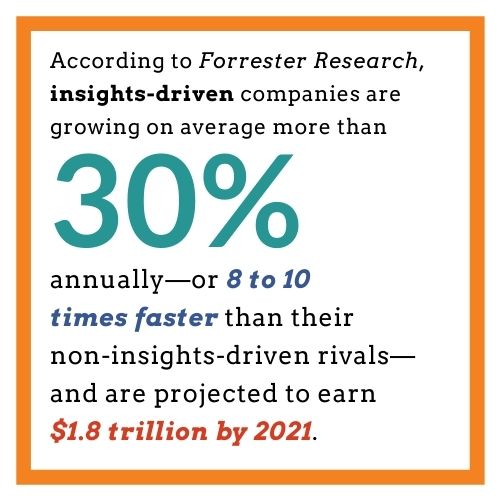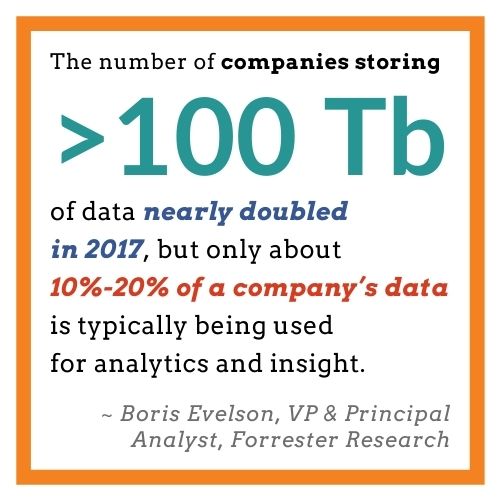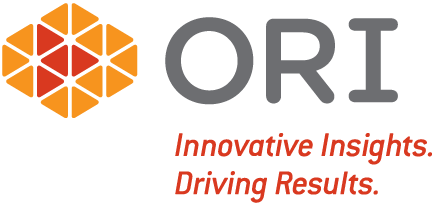High Stakes: The Benefits & Challenges of Translating Data into Insight
By Jay Yeo, Consultant, ORI
We all know that exceptional customer experience (CX) hinges on high-quality data. Despite this universal truth, many organizations struggle to translate their data into insight—even though the payoff can be monumental.  Forrester Research reports that insights-driven companies are growing at an average of more than 30% annually, which translates to eight to 10 times the growth of their non-insights-driven counterparts and a projected $1.8 trillion in earnings by 2021.
Forrester Research reports that insights-driven companies are growing at an average of more than 30% annually, which translates to eight to 10 times the growth of their non-insights-driven counterparts and a projected $1.8 trillion in earnings by 2021.
If being able to translate data into insight yields such clearly valuable rewards, why is it that organizations still struggle to do so? The challenge often lies in one of two places (or both): ensuring data quality and making use of all data to connect analysis to organizational goals and priorities that impact the bottom line. So what can you do about it—and what are the implications for your organization?
Data Quality & the Hidden Challenge of Data Decay
The first step to ensuring that data can be turned into insights effectively is to begin with high-quality data. Often the best way to start is with a benchmarking exercise to assess the current health of the data (for more on data benchmarking, read Knowing Where You Stand: Data Benchmarking & the Importance of Understanding the Status of Your Data).
Once you have a sense of where your data stands, you can undertake gap filling and data collection efforts to improve the base data quality. Key to this process is the exercise of identifying those fields that are most essential to running and improving the organization. Insights are only as good as the data underlying them, and data is only as good as the strategy that surrounds it.
Ensuring that an organization has high-quality data is not, however, a one-and-done exercise. One of the hidden challenges of data quality is data decay: when data becomes less usable over time due to natural shifts and changes within a customer or member base. According to Quadient, data decays at an average rate of 2% per month—with a whopping 25% to 30% of an organization’s contact data slated to go bad each year. That means that maintaining high data quality for maximum insight requires regular check-ins and data collection points to ensure that data stays up to date.
Making the Most of Your Data: Connecting Data to Insight & Overcoming Data Silos
Maintaining up-to-date, high-quality data is only half the battle. In order to make the most of your data, it must be connected to the organization’s strategic goals. Additionally, the various segments of data need to be connected to one another. Connecting data to organizational goals requires careful forethought about organizational priorities, which metrics are most important to measure progress, which questions or segments are of particular interest, and how data will be presented and used to support decision making. Doing so will ensure that insights derived from data—and the subsequent actions taken—will result in progress toward achieving organizational goals.
Once an organization has agreed upon its data priorities and strategy, the next challenge is to ensure that it is taking advantage of all of its data by breaking down and avoiding data silos.  In 2017, the number of companies storing more than 100 terabytes of data nearly doubled, but the insights organizations are extracting represent only a small subset of all data available, says Boris Evelson, VP and principal analyst at Forrester Research. He ventures that roughly 10% to 20% of a company’s overall data is being tapped for analytics and insight—taking into account structured and unstructured as well as internal and external data. Being able to combine disparate data sources is key to producing an accurate and robust analysis to meet organizational needs (for more, read How to Overcome Data Silos to Strengthen Customer Experience).
In 2017, the number of companies storing more than 100 terabytes of data nearly doubled, but the insights organizations are extracting represent only a small subset of all data available, says Boris Evelson, VP and principal analyst at Forrester Research. He ventures that roughly 10% to 20% of a company’s overall data is being tapped for analytics and insight—taking into account structured and unstructured as well as internal and external data. Being able to combine disparate data sources is key to producing an accurate and robust analysis to meet organizational needs (for more, read How to Overcome Data Silos to Strengthen Customer Experience).
Though turning data into insight requires effort and forethought and often presents challenges to overcome, the payoffs are huge. The Forrester statistics are a reminder that organizations cannot afford to roll the dice on their future success by leaving their data by the wayside.












